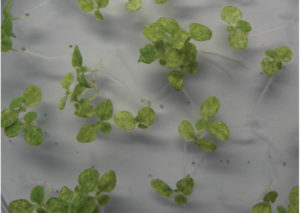MatK – an ancient regulator of chloroplast gene expression
Land plant chloroplast RNAs are heavily processed post-transcriptionally. Next to end processing and RNA editing, a prominent processing step is RNA splicing of group II introns. Group II intron splicing is mediated predominantly by nuclear-encoded RNA binding proteins, of which about a dozen have been described in maize or Arabidopsis. In addition to this nuclear complement of splicing factors, there is a single chloroplast-encoded splicing factor named intron maturase K, short MatK. The MatK protein is related to prokaryotic intron maturases. Bacterial intron maturases are encoded within a group II intron, i.e. their “home intron”. The home intron of MatK is located in the trnK gene.
A role in splicing for MatK is also suggested by studies on chloroplasts devoid of a translational apparatus. In these mutants, the trnK precursor RNA is not spliced. In addition, an entire subgroup of chloroplast introns termed group IIA introns fails to splice as well. The only conceivable factor that would require functioning chloroplast translation for splicing is MatK, which led to the proposition that MatK serves splicing of all group IIA introns. Indeed, direct association of MatK with intron RNA was demonstrated in vitro and with seven group IIA introns by us in vivo.
Recently, we unexpectedly identified MatK as a regulator of tRNA abundance, which impacts global chloroplast translation. We currently unravel the details of its regulatory and mechanistic functions during plant development.
